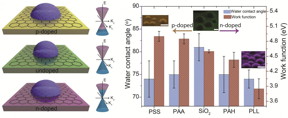University of Illinois researchers demonstrate tunable wetting and adhesion of graphene
Researchers from the University of Illinois at Urbana-Champaign have demonstrated doping-induced tunable wetting and adhesion of graphene, revealing new and unique opportunities for advanced coating materials and transducers.
"Our study suggests for the first time that the doping-induced modulation of the charge carrier density in graphene influences its wettability and adhesion," explained SungWoo Nam, an assistant professor in the Department of Mechanical Science and Engineering at Illinois. "This work investigates this new doping-induced tunable wetting phenomena which is unique to graphene and potentially other 2D materials in complementary theoretical and experimental investigations."

Doping-induced tunable wetting of graphene.
Graphene, being optically transparent and possessing superior electrical and mechanical properties, can revolutionize the fields of surface coatings and electrowetting displays, according to the researchers. A material's wettability (i.e. interaction with water) is typically constant in the absence of external influence and are classified as either water-loving (hydrophilic) or water-repelling (hydrophobic; water beads up on the surface). Depending on the specific application, a choice between either hydrophobic or hydrophilic material is required. For electrowetting displays, for example, the hydrophilic characteristics of display material is enhanced with the help of a constant externally impressed electric current.
"What makes graphene special is that, unlike conventional bulk materials, it displays tunable surface wetting characteristics due to a change in its electron density, or by doping," said Ali Ashraf, a graduate student researcher and first author of the paper, "Doping-Induced Tunable Wettability and Adhesion of Graphene," appearing in Nano Letters. "Our collaborative research teams have discovered that while graphene behaves typically as a hydrophobic material (due to presence of strongly held air-borne contamination on its surface), its hydrophobicity can be readily changed by changing electron density.
"Our study shows for the first time that graphene demonstrates tunable wettability -- switchable hydrophobic and hydrophilic behavior -- when its electron density is changed by subsurface charged polymers and metals (a.k.a. doping)," Ashraf added. "This finding sheds lights on previous unclear links between quantum-level charge transfer and macroscopic surface wettability for graphene. This exciting finding opens new doors of possibility for tunable surface coating and electrowetting displays without continuous external electric current supply, which will translate into significant energy savings."
"In addition, we investigated another closely related property -- surface adhesion," Nam said. "We observed changes in electron density of graphene leads to a change in adhesion, which determines how graphene interacts with other hydrophobic and hydrophilic molecules, which is important for graphene-based chemical and biosensors. Our finding suggests that it is possible to make reusable, self-cleaning graphene sensors that can first interact with hydrophobic molecules for detection, and then separates from them (i.e. cleans itself) by enhanced hydrophilicity via electron density modulation."
Source: Nanotechnology Now
- 348 reads
Human Rights
Ringing FOWPAL’s Peace Bell for the World:Nobel Peace Prize Laureates’ Visions and Actions

Protecting the World’s Cultural Diversity for a Sustainable Future

The Peace Bell Resonates at the 27th Eurasian Economic Summit

Declaration of World Day of the Power of Hope Endorsed by People in 158 Nations

Puppet Show I International Friendship Day 2020

